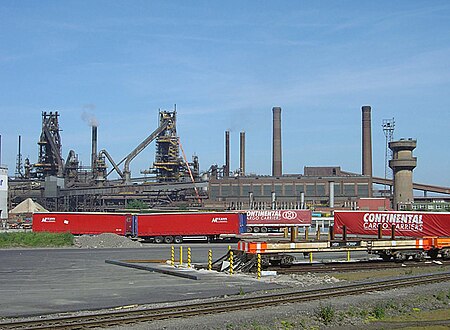Scunthorpe Steelworks

The Iron and Steel Industry in Scunthorpe was established in the mid 19th century, following the discovery and exploitation of middle Lias ironstone east of Scunthorpe, Lincolnshire, England. Initially iron ore was exported to iron producers in South Yorkshire. Later, after the construction of the Trent, Ancholme and Grimsby Railway (1860s) gave rail access to the area local iron production rapidly expanded using local ironstone and imported coal or coke. The local ore was relatively poor in iron (around 25% average) and high in lime (CaCO3) requiring co-smelting with more acidic silicious iron ores. The growth of industry in the area led to the development of the town of Scunthorpe in a formerly sparsely populated entirely agricultural area. From the early 1910s to the 1930s the industry consolidated, with three main ownership concerns formed – the Appleby-Frodingham Steel Company, part of the United Steel Companies; the Redbourn Iron Works, part of Richard Thomas and Company of South Wales (later Richard Thomas and Baldwins); and John Lysaght's Normanby works, part of Guest, Keen and Nettlefolds. In 1967 all three works became part of the nationalised British Steel Corporation (BSC), leading to a period of further consolidation – from the 1970s the use of local or regional ironstone diminished, being replaced by imported ore via the Immingham Bulk Terminal – much of the steelworks was re-established with equipment at or south and east of the Appleby-Frodingam works during the late 1960s as part of the Anchor modernisation. Primary iron production was at four blast furnaces first established or expanded in the 1950s, and known as the four Queens: named Queen Anne, Bess, Victoria, and Mary. Both the Normanby Park and the Redbourn works were closed by the early 1980s. Conversion to the Linz-Donawitz process (LD) of steel making from the open hearth process took place from the late 1960s onwards, with an intermediate oxygen utilising open hearth process known as the AJAX furnace operated in the interim – conversion to LD operation was complete by the 1990s. Following privatisation in 1988, the company together with the rest of BSC became part of Corus (1999), later Tata Steel Europe (2007). In 2016 the long products division of Tata Steel Europe was sold to Greybull Capital with Scunthorpe as the primary steel production site.
Excerpt from the Wikipedia article Scunthorpe Steelworks (License: CC BY-SA 3.0, Authors, Images).Scunthorpe Steelworks
Ore Blending Road,
Geographical coordinates (GPS) Address Nearby Places Show on map
Geographical coordinates (GPS)
| Latitude | Longitude |
|---|---|
| N 53.581944 ° | E -0.60786 ° |
Address
Ore Blending Road
Ore Blending Road
DN16 1XA
England, United Kingdom
Open on Google Maps







